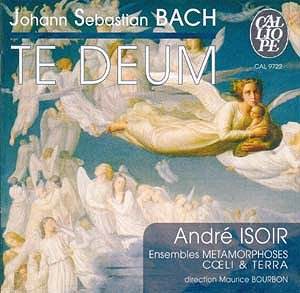Bach’s chorale Herr Gott, dich loben wir, BWV 725,
has come down to us in a manuscript copy made by his first biographer,
Forkel. This chorale is the Lutheran version of the Latin Te Deum. Its
inclusion of the incipit of each of the verses raises the possibility
that it might have been intended for a choir as well as for the organ.
A collection of chorales made by C. P. E. Bach around 1785 includes
a Te Deum in the same key as this organ chorale.
André Isoir, performer of one of the finest
complete recordings of Bach’s organ works, superimposed the voices over
the organ score, leading to the result heard here in the first track
on this disc. The other tracks are also combinations of vocal works
and organ chorales – sometimes the vocal works are the same chorale,
and sometimes they are different works (chorales with the same name
but different BWV numbers). "The general construction is based
on the principle of alternation of highly accomplished instrumental
pieces with their homophonic four-part vocal counterparts, as they appear
in certain cantatas, for example…"
Basically, this recording is a "creation"
of new Bach works from old ones. As an experiment, one could easily
call it pure speculation, yet the result is quite effective. With a
deeply meditative liturgical atmosphere, this disc shows very well the
relationship between organ chorales and vocal works. The first track,
the Te Deum, contains some beautiful vocal textures within a very mellow,
rich atmosphere. This track contains a superimposition of voices over
the organ, as do two others. But most of the recording is made up of
sets of homophonic chorales in two or three parts, with voices singing
in one section and the organ playing in another.
Nun freut euch, lieben Christen g’mein, is an organ
work with arabesques of melodies in the higher end of the organ. When
the vocal section comes in it sounds more like a motet or a hymn. There
is not, therefore, always a thematic relation between the various sections;
this is textual more than musical.
Yet the recording works quite well. Isoir’s playing
is brilliant, as in his other Bach recordings. He uses very simple registrations,
focusing more on the melodies of the chorales than the force of the
instrument (with the exception of the powerful final track, the De Profundis).
The vocal performances are also fine, with excellent balance and texture
from the various ensembles.
Here is a unique recording of music that Bach never
wrote. The combination of organ chorales and vocal sections works quite
well. The atmosphere of the disc is very compelling, and the performances
excellent. With a very mellow, spiritual feeling, this disc is very
satisfying, and is a welcome addition to any collection of Bach’s sacred
music.
Kirk McElhearn


![]() André Isoir, organ
André Isoir, organ
![]() CALLIOPE 9722 [54.53]
CALLIOPE 9722 [54.53]